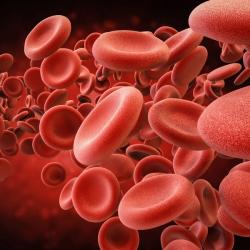
OR WAIT null SECS
Clotting Risk Persists Nearly a Year Following COVID-19 Infection
An analysis of data from more than 48,000,000 individuals is providing insight into the duration of extended risk for thrombosis among people who have experienced a COVID-19 infection.
Conducted by the CVD-COVID-UK/COVID-IMPACT Consortium and the Longitudinal Health and Wellbeing COVID-19 National Core Study, results of the analysis, which leveraged population-wide anonymized linked English and Welsh electronic health records, indicate the hazard ratios for arterial thrombosis or venous thromboembolism (VTE) was greatest in the first week following COVID-19 diagnosis and dissipated over time, but remained present through 49 weeks.
“We are reassured that the risk drops quite quickly – particularly for heart attacks and strokes – but the finding that it remains elevated for some time highlights the longer-term effects of COVID-19 that we are only beginning to understand,” said Jonathan Sterne, PhD, MSc, professor of Medical Statistics and Epidemiology at the University of Bristol, director of the NIHR Bristol Biomedical Research Centre, in a statement.
In the early days of the pandemic, excess risk of thrombosis was identified as one of the first nonpulmonary adverse events to be associated with COVID-19 infection. Now, nearly 2 years removed from the first wave of the pandemic, risk of major arterial and cerebrovascular disease following COVID-19 infection remains both a major research need and concern for clinicians and patients.
With this in mind, Sterne and a team of more than 2 dozen colleagues from the Universities of Bristol, Cambridge, and Edinburgh, and Swansea University designed the current study with the intent of investigating the extent and duration of excess risk for thrombosis associated with a COVID-19 diagnosis using EHR data from individuals registered with a primary care general practice in England or Wales on January 1, 2020.
Using EHR data from these patients, investigators designed their analyses to estimate adjusted hazard ratios for the incidence of arterial thromboses and VTEs after diagnosis of COVID-19 with the incidence in people without a COVID-19 diagnosis. Investigators noted subgroup analyses were conducted according to COVID-19 severity, demographic characteristics, and previous history.
From the 48,000,000 individuals included in the study, 125,985 were hospitalized and 1,319,789 were not hospitalized within 28 days of their respective COVID-19 diagnoses. Among those in England, a total of 260,279 first arterial thromboses and 59,421 first VTEs during 41.6 million person-years of follow-up. In adjusted analyses, results indicated the hazard ratio risk for first arterial thrombosis after COVID-19 compared to not having a COVID-19 diagnosis declined from 21.7 (95% CI, 21.0-22.4) in the first week after diagnosis to 1.34 (95% CI, 1.21-1.48) during weeks 27-49. Further analysis demonstrated the adjusted hazard ratios for first VTE after a COVID-19 diagnosis declined from 33.2 (95% CI, 31.3-35.2) in the first week after diagnosis to 1.80 (95% CI, 1.50-2.17) during weeks 27-49.
In subgroup analyses, results suggested adjusted hazard ratios for each were higher for longer after diagnosis, after hospitalized vs nonhospitalized COVID-19, among Black or Asian individuals compared to White people, and among those without a previous event compared to those with a history or an event. Investigators highlighted the estimated whole-population increases in risk of arterial thromboses and VTEs 49 weeks after COVID-19 diagnosis were 0.5% and 0.25%, respectively, which correlates to 7200 and 3500 additional events, respectively, after 1.4 million diagnoses.
In the aforementioned statement, William Whiteley, BMBCh, MSc, PhD, a study investigator and clinical epidemiologist and neurologist at the University of Edinburg, noted further research is needed to better inform evidence-based approaches to management of thrombosis following COVID-19 infection.
“The effect that coronavirus infection has on the risk of conditions linked to blood clots is poorly studied, and evidence-based ways to prevent these conditions after infection will be key to reducing the pandemic’s effects on patients,” Whiteley said.
This study, “Association of COVID-19 With Major Arterial and Venous Thrombotic Diseases: A Population-Wide Cohort Study of 48 Million Adults in England and Wales,” was published in Circulation.


